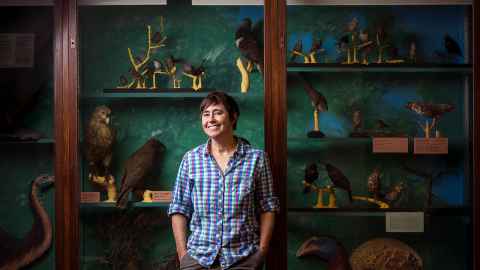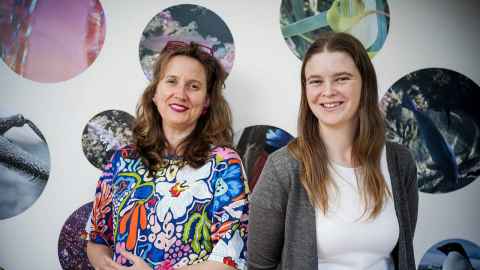Unlocking animal senses
30 May 2025
Feature: Megan Fowlie meets University of Auckland researchers tuning into how animals see and hear the world and offering new insights into the often-hidden lives of our fellow creatures.

Patience and a keen eye can go a long way when spotting songbirds in the bush. One of the most challenging to spy is New Zealand’s tiniest bird, the titipounamu. Also known as the rifleman, the titipounamu has plumage resembling army fatigues: green in males and streaky brown in females.
These colours form helpful camouflage against many predatory birds and mammals. But we are not seeing the whole picture. To each other, these tiny birds flash like neon signs, in purples, hot pink and bands of gold through the lush native forest.
Associate Professor Kristal Cain and a team of fellow biologists at the University of Auckland, fascinated by these tiny ancient endemic wrens, tracked titipounamu through the Mangaharuru Range in Tairāwhiti and at the Zealandia sanctuary in Wellington. They were looking to see if the old story held true that males are camoed for leaves and females for bark. The team, however, uncovered little difference between the whereabouts of males and females and the colour of their surroundings.
“The males are not hanging out more on green things and the females are not hanging out more on brown things,” says Kristal. “Instead, they are all over the place – and to each other they are glowing. Their eye rings and wing patches flashing in ultraviolet hues. It’s a clever double act.”
For the most part, human and bird colour vision is not terribly different. People have three photoreceptors tuned to blue, green and red wavelengths, which allow us to see a combination of those primary colours. Some birds are equipped with violet cones, which allow them to see purples beyond the purple visible to the human eye, and some have ultraviolet receptors.
“Blue, white and iridescence, even some greens reflect ultraviolet very strongly. So, when we think about how birds find food, how birds communicate with each other, they are able to see a channel that none of us are able to see,” says Kristal.
“For the little titipounamu, this bright techno-colouration might really be a show of sexiness.”
It turns out, many of our songbirds are flashing secret ciphers with their feathers and bills, flirting and foraging using a semaphore system hidden from humans and predators.
What’s equally intriguing is that sending these signals, emanating from the blue end of the colour spectrum, is costly. Blue simply doesn’t exist as a feather colour; instead, the blue appearance is achieved via clear feathers with micro angles that bounce blue light as sunlight strikes them. In addition, achieving green feathers requires birds to forage for a diet high in yellow/orange-producing carotenoids.
“Birds are, albeit often secretly from us,” says Kristal, “going to a lot of trouble to show off.”
For the little titipounamu, this bright techno-colouration might really
be a show of sexiness
A model for colour
The physics of colour and understanding of how animals see the world took a great leap forward at the end of last century when Misha Vorobyev developed a model of colour vision.
Misha is a physicist and mathematician at the School of Optometry and Vision Science at the University of Auckland. In the 1990s, he won a Humboldt Fellowship in the Free University of Berlin to follow his passion for colour and unravel the love affair between flowers and insect vision.
During this work, he developed a mathematical model to interpret experimental data on bees – a model that also held true for human vision. His code is now used by scientists around the globe to predict the colour thresholds of animals and allow them to accurately ‘see’ the colours that these animals experience.
“Fundamentally, we are alike: bees, birds, humans,” says Misha. “The physics behind sight is absolutely the same.”
Misha’s intoxication with colour began during his childhood when he would visit the art-filled gilt and tiled halls of the Hermitage in St Petersburg, Russia.
The pursuit of colour ultimately carried him south to a dream project on Australia’s Great Barrier Reef. He explored the striking underwater mosaic of coral fish, how they see each other to blend in or become conspicuous against the corals as light is absorbed and scattered through the salt water.
“The same engineering can be applied to commercial fishing,” says Misha. “Under certain illumination, trawl nets are easily visible to some fish, but not to others. Equally, light can attract some fish but repel others.
“Adjusting the illumination of trawl nets could increase the catch of commercially valuable fish but, more importantly, decrease the catch of unwanted ones. Even small decreases of bycatch have a significant commercial value.”
Recently, Misha began collaborating with a New Zealand start-up, which has developed artificial intelligence that recognises fish in the vicinity of trawl nets to inform skippers on how to operate the trawls.
“We hope by putting efforts together, to have smart lights which rapidly change settings to reduce unwanted bycatch and increase catch,” says Misha. “This will also save lives of endangered New Zealand marine mammals and penguins, which are occasionally injured or killed by trawl nets.”
He is now throwing out a line to other potential partners in the fishing industry to collaborate in this research area.

A forest for the senses
Biological Sciences Associate Professor Anne Gaskett has a lifelong interest in considering animals, flowers, and fungi from the perspective of others.
“When it comes to colour, it is the viewer that drives selection for colourfulness,” she notes.
New Zealand forests are packed with brightly coloured fruits and fungi. She poses the question: “Whose vision have they evolved in response to?”
“Birds have red receptors selecting for red forest fruits. But other animals like skinks, geckos and wētā also eat fruit. So, those forest fruits might be talking to a wider range of animals,” she says.
“To fully understand how forests work, we should consider the animals’ perspectives. Fruits and flowers evolved for specific animals, so we should think about what fruits and flowers are available throughout the annual cycle, and over the years into the future.”
Researchers across the University have been making close examinations of animals’ sensory organs and the behavioural responses of animals to the sights and sounds in their environments.
One is Gyoungsu Lee, a doctoral student working under Anne, who is observing native skinks at Auckland Zoo to understand what colours and smells are more or less attractive and how that might relate to their survival in the wild.
Meanwhile, deep in the forests of Waikato and Taupō, Kristal Cain, masters student Alisha Hart and Department of Conservation science adviser Kerry Borkin created phantom traffic highways, aiming to understand the impact of noise pollution on New Zealand’s short-tailed native bat.
Bats do have eyes, but they primarily navigate the world via echolocation, emitting high frequency sound pulses through their nose and mouth and listening for the echo.
Kerry and Kristal lined forest environments with speakers, then funnelled pre-recorded road noise through the trees and eavesdropped for bats using high-frequency detectors along their ‘ghost road’.
“The short-tailed bat is the only species in its family in the whole world, so it is quite special. As we chop up the country by putting roads through, that segregates and fragments the bat habitat and their ability to move around,” says Kristal.
“In our study, we see a really large effect. When there is road noise, bats avoid that area. There are many ways to interpret that: they might be unable to hear their prey or unable to navigate their habitat, but at the heart, the bats are avoiding the area when there is a lot of traffic noise.”
To fully understand how forests work, we should consider the animals’
perspectives.
What sharks hear
Marine scientist Professor Craig Radford is working to mitigate the cacophony in the world’s oceans through a better understanding of how sharks sense sound, by looking at the structural properties and sensitivities of sharks’ ears.
Yes, sharks have ears. And these semi-circular canals of shamrock-like cartilage are fully encapsulated under the shark’s skin. Craig’s Marsden-funded project involved using MRI scans of deceased bycatch, and examining the ears from dozens of species – from carpet sharks and school sharks to makos and hammerheads caught around the Hauraki Gulf.
“One person’s ears have a very similar structure to another’s, but that’s not so in the shark world. Fish are the most diverse group of vertebrates on Earth, and we see great diversity in their ears.”
So far, findings show that ear size correlates with hearing ability – and relates to where the sharks spend most of their time, whether that’s in the sea column or hunkering down on the seabed. Carpet sharks have a very narrow audio bandwidth and don’t hear too well, for example, while rig sharks, with massive ears, have great hearing. There’s also a lot of variation in the size and shape of the cartilage loops that help the fish orient themselves in the deep ocean.
“Underwater is such a dynamic environment,” says Craig. “When you think about animals out in the big blue, there are very few visual cues. That’s where sound becomes really important. It is omni-directional, it spreads equally in all directions from the source, and it travels almost five times faster in water than it does in the air.”
One person’s ears have a very similar structure to another’s, but that’s not so in the shark world.
Sustainable impact
Research Fellow Dr Ariel-Micaiah Heswall has also been working with Anne and Kristal to understand the impact of our bright, artificially lit city on seabirds’ lives. A quarter of the world’s seabird species, around 90 different kinds, live, eat or breed around the northern region of New Zealand. Only a handful of remote places on Earth can claim such seabird diversity.
Ariel’s research involved mapping seabird crash locations to light pollution grids over the Auckland isthmus between 2018 and 2021. The results were conclusive: each square of the city that had brighter lights had more collisions.
“This is something very solvable,” says Anne. “At specific times of the year, we could reduce light intensity by turning off or dimming lights that are not essential for safety, and save a lot of these special taonga seabirds.”
The Cooks’ petrels are a good example of animals in danger. Every March, fledglings are injured or killed as they embark on their maiden voyage with undeveloped eyes and fly over central Auckland, a gauntlet of lights, to the city’s West Coast. Dazzled and confused by light pollution, they collide with buildings and get serious head and internal injuries. If seabirds become grounded and unable to take off, they can get more injuries or be killed by dogs, cats or cars.

The next step for Anne and Ariel is to conduct ‘dimming’ trials with interested business owners.
In another study, Ariel cross-referenced five years of sea birds identified in bycatch data with physical measurements of taxidermied animals stored at the Auckland War Memorial Museum. The outcome: big-eyed birds with large nostrils were hooked into nets and lines more frequently than others. Ariel surmises that these birds with greater visual and olfactory capacity may be more attracted to bait, offal and brightly lit fishing boats.
She points to simple interventions that might act as sensory deterrents. “Dyeing bait blue to reduce the contrast with the ocean, attaching shiny streamers to fishing vessels, or more circumspect timing for releasing offal.”
Kristal Cain sums up. “There’s so much incredible information out there to make our world more sustainable,” she says, “but it requires us to pay attention to these animals that we often think of as not having that much to teach us.”
All animal work done at Waipapa Taumata Rau, University of Auckland was approved by the University’s Animal Ethics Committee. Information on animal-based research at the University of Auckland can be found here.
auckland.ac.nz/en/research/about-our-research/openness-in-animal-research.html
This article first appeared in the Autumn 2025 issue of Ingenio.